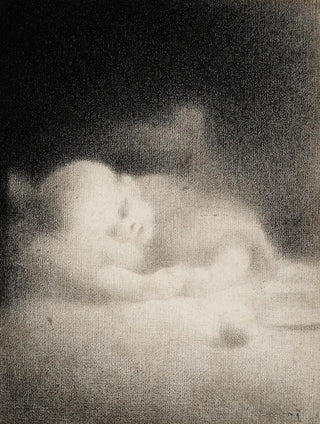Art print | Study of Sleeping Child - Charles Angrand


View from behind

Frame (optional)
The artwork "Sleeping Child Study" by Charles Angrand is a delicate representation of innocence and serenity of childhood. This painting, imbued with a peaceful atmosphere, invites the viewer to immerse themselves in a universe where time seems suspended. The artist, through this piece, captures a fleeting moment, that of a sleeping child, symbol of purity and vulnerability. The beauty of this scene lies not only in the chosen subject but also in the way Angrand manages to convey deep emotions through his pictorial technique. This artwork is much more than a simple study; it is a celebration of life and its sweetest moments.
Style and uniqueness of the work
Charles Angrand's style is distinguished by his post-impressionist approach, characterized by dynamic brushstrokes and a palette of vibrant colors. In "Sleeping Child Study," the artist uses soft and harmonious tones that evoke tenderness and tranquility. The composition, though simple, is of great visual richness, each element carefully orchestrated to create a serene ambiance. Angrand skillfully plays with light, highlighting the contours of the child's face and emphasizing the softness of their features. This artwork, through its realism and poetry, demonstrates the artist's skill in capturing the very essence of his subject, transforming an ordinary moment into a timeless masterpiece.
The artist and his influence
Charles Angrand, an emblematic figure of the post-impressionist movement, managed to leave his mark on his era with his unique vision and commitment to art. Born in Normandy, he was influenced by artists such as Georges Seurat and Paul Signac, adopting divisionist techniques that allowed him to experiment with colors and light in innovative ways. Angrand was also a passionate advocate for art as a means of personal and social expression. Through his works, he addresses various themes, ranging from everyday life to deeper reflections on existence. "Sleeping Child Study" fits within this lineage, illustrating not only his talent,

Matte finish

View from behind

Frame (optional)
The artwork "Sleeping Child Study" by Charles Angrand is a delicate representation of innocence and serenity of childhood. This painting, imbued with a peaceful atmosphere, invites the viewer to immerse themselves in a universe where time seems suspended. The artist, through this piece, captures a fleeting moment, that of a sleeping child, symbol of purity and vulnerability. The beauty of this scene lies not only in the chosen subject but also in the way Angrand manages to convey deep emotions through his pictorial technique. This artwork is much more than a simple study; it is a celebration of life and its sweetest moments.
Style and uniqueness of the work
Charles Angrand's style is distinguished by his post-impressionist approach, characterized by dynamic brushstrokes and a palette of vibrant colors. In "Sleeping Child Study," the artist uses soft and harmonious tones that evoke tenderness and tranquility. The composition, though simple, is of great visual richness, each element carefully orchestrated to create a serene ambiance. Angrand skillfully plays with light, highlighting the contours of the child's face and emphasizing the softness of their features. This artwork, through its realism and poetry, demonstrates the artist's skill in capturing the very essence of his subject, transforming an ordinary moment into a timeless masterpiece.
The artist and his influence
Charles Angrand, an emblematic figure of the post-impressionist movement, managed to leave his mark on his era with his unique vision and commitment to art. Born in Normandy, he was influenced by artists such as Georges Seurat and Paul Signac, adopting divisionist techniques that allowed him to experiment with colors and light in innovative ways. Angrand was also a passionate advocate for art as a means of personal and social expression. Through his works, he addresses various themes, ranging from everyday life to deeper reflections on existence. "Sleeping Child Study" fits within this lineage, illustrating not only his talent,






